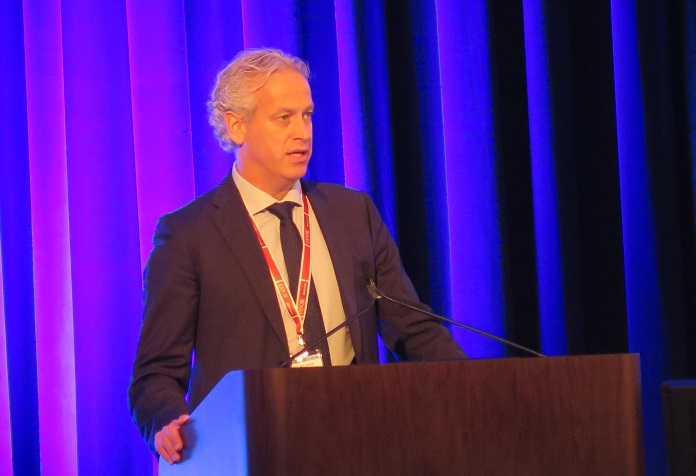
A Dutch study of greater saphenous vein insufficiency patients has found that mechanochemical ablation (MOCA; ClariVein, Vascular Insights) is an effective and safe treatment with low postoperative pain and fast recovery.
Speaking at the 2016 VEITHsymposium (15–19 November, New York, USA), Michael Reijnen, Rijnstate Hospital, Arnhem, The Netherlands, also noted that results in mid-term follow-up were “within an acceptable range,” and that there seems to be a drop in clinical outcomes at three years.
A combination of mechanical damage and sclerotherapy, MOCA uses a rotating wire to cause cellular damage to the intimal layer of the vein and result in spasm. With sclerosants penetrating the vessel wall, this results in obliteration. Reijnen stressed that the process does not require tumescence anaesthesia, and that this is “not a variation on foam sclerosing”. MOCA is potentially preferable to endothermal ablation, Reijnen explained, as it avoids the need for tumescence, negates the risk of thermal injury and offers lower levels of postoperative pain.
Reijnen and colleagues treated 104 greater saphenous veins in 85 patients at two participating centres. Sixty-nine per cent of these patients were female, with 34% CEAP classification 2 (C2), 30% C3 and 27% C4. Mean VCSS score was 4 (range 1–13). The mean diameter of the treated veins was 5.2mm (range 3.5–12.8mm) and the length of treated segment was 45cm (range 20–62cm). Mean procedural time was 11 minutes (range 6–25 minutes) and technical success was 99%. Polidocanol was used as the sclerosant, with the proximal 10cm treated with 2mL of polidocanol 2% and the remaining vein with polidocanol 1.5%. Compression stockings were used continuously for the first 24 hours post-procedure and then for two more weeks during the daytime. Patients returned to full activity immediately.
One-year outcomes, previously presented by Reijnen and colleagues, showed average post-procedural pain score (at 14 days) was 7.5mm on a scale from 0–100. Time to work resumption and to normal activities were both a mean of one day, and 22% of the patients required some form of adjunctive treatment. One-year anatomical success was 88% and clinical success was 93%. In the patients treated, mean AVVQ score had improved from 6.6 (range 4–11) at baseline to 2.4 (range 0.5–6.2). At three years (with a median follow-up of 36 months; range 12.5–46.3 months), 14 patients (16%) had been lost to follow-up, with one death caused by intracranial haemorrhage. Recanalisation was observed in 15 (14.7%) veins, with eight (7.8%) complete recanalisations. Anatomical success was reported at 86.5% at three years with clinical success at 83%. Reijnen pointed out that “VCSS significantly deteriorated from 1.2±1.4 at 12 months to 1.8±1.5 at 36 months, although the differences in absolute figures are small”.
Reijnen reported a significant improvement in quality of life as demonstrated by AVVQ scores at all time points when compared to baseline (8.8 at three years, range 2.5–29.4). There was, however, an increase in “the subjective amount of varicose veins drawn on each leg at 36 months compared with one year”.
“In conclusion, MOCA is proven to be effective and safe for treating greater saphenous vein insufficiency,” Reijnen said. Reflecting on the results, he suggested that although short- and mid-term outcomes are encouraging, the drop in clinical outcome at three years must be noted. He added, “It is important to realise that these were the first patients that were treated after our initial safety studies. As such, we are still on our learning curve and progression in technique, which has already changed since then, is likely to improve our anatomical results.”









